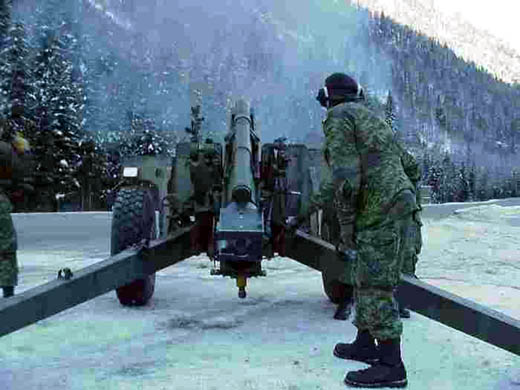
6 December 2006
Canadian Troops Deployed for Avi Control at Rogers Pass

Revelstoke British Columbia - More than 2,000 motorists
travel the Trans-Canada Highway through Rogers Pass during winter's treacherous months - all thanks to these guys and
gals - Canada's troops.
For over 45 years, the 1st Royal Canadian Horse Artillery (1 RCHA) from Canadian Forces Base Shilo, Manitoba, has used artillery fire
to assist Parks Canada with avalanche control in Rogers Pass/Glacier National Park, British Columbia. This year is no different, as
troops have already been deployed to the Pass.
Artillery fire from 105 mm howitzers, towed to one of 18 roadside circular gun platforms, is often used to artificially trigger an
avalanche rather than risk the volatility of a naturally occurring avalanche. "Our goal is to induce an avalanche before it can
become larger and therefore a danger to traffic," said Lieut. Robert Vandermolen, Troop Commander of the 13 soldiers who will
leave their homes and families this winter to protect motorists.
Parks Canada operates the world's largest mobile avalanche control program to keep the Trans-Canada Highway and the
Canadian Pacific Railway operating through Rogers Pass. During winter months, snow avalanche technicians maintain a constant watch
over weather and snowpack conditions. The artillery takes its cues on when and where to fire from these snow experts.
"The only live fire that happens on the highway is in defense of that highway and is coordinated by my team," said Bruce
McMahon, the Senior Avalanche Officer at Mount Revelstoke and Glacier National Parks. "We close and sweep the highway in the area
of concern to ensure there are no civilian vehicles within the danger or avalanche areas before beginning avalanche control
operations."
Under the direction of the avalanche forecasters from Parks Canada, the army bombards known trigger zones high up the avalanche paths.
The shock waves from exploding shells fired by the artillery will trigger avalanches when snow conditions are right. With the highway
closed, the avalanches can thunder harmlessly down the slopes.
The program also employs road crews, including snowplow drivers and traffic control workers from local residents in Golden and
Revelstoke, to keep the road clear. "It's a team effort," said Lieut. Vandermolen. "Parks Canada personnel are
coordinators, road crews remove snow and ice, and us Army guys are the "snow-punchers." Each of us plays an
essential part and lends expertise in our related fields."
Were it not for the work of this avalanche control team, long-term road closures could mean a huge inconvenience to
commuters. "In a century of searching, surveyors have located only one likely route across the central Selkirks: Rogers
Pass. Without this pass, all railways and highways would have to take a lengthy detour around the mountains," affirmed Mr.
McMahon.
Not only does avalanche control allow motorists to rely on a safe provincial transportation system during the winter, the programme
also ensures that the commercial route to and from B.C.'s west coast is open for business. "Every hour the highway is closed, it
incurs costs in lost shipping on both the highway and rail lines in the area," said Lieut. Vandermolen. "Using the artillery
to induce the avalanche allows us to determine when an avalanche will take place, preventing hours, maybe days of road closures that
could result if we were to wait for nature."
|